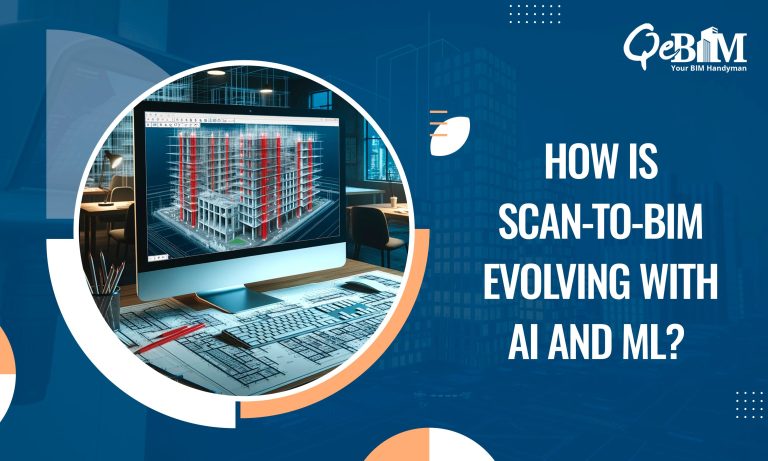How is Scan-to-BIM Evolving with AI and ML?

Scan-to-BIM is a term that has gained a significant traction in the BIM industry. It has become one of the most sought-after technologies among the AEC professionals for its transformative impact. By speeding up the digitization process, Scan-to-BIM provides accurate As-built Models for renovations, retrofit, refurbishment as well as for the expansion projects too. This approach is not only cost-efficient but also plays a crucial role in mitigating the project risks.
The conventional process for Scan-to-BIM includes scanning a structure, processing the registered point cloud data and converting it into a BIM model that adheres to the industrial standards. However, these tasks are time-intensive and heavily reliant on the manual efforts.
What if the standard Scan-to-BIM workflow could be automated and optimized for better efficiency? This is where AI and ML technologies falls in to the picture. AI and ML enable smarter, faster and way more efficient conversions, calling for a new era in the AEC industry.
A Brief About Scan-to-BIM, AI and ML
Scan-to-BIM is a process where the laser scanning technology or photogrammetry is used to capture the physical dimensions and details of any existing structure. This data is then transformed into a precise 3D digital model, referred to as a Building Information Model (BIM). This BIM model serves as a rich repository of information that aids in the renovation, facility management as well as the retrofit projects. The companies offering Scan to BIM Services guarantees that the process is executed with the highest level of precision and efficiency.
Artificial Intelligence (AI) and Machine Learning (ML) are the technologies that enables the machines to simulate the human intelligence and learn from the data patterns. AI on one hand provides the cognitive capabilities such as pattern recognition and decision-making while ML on the other hand refines these abilities by enabling the systems to improve over time through the experience. Together, they both offers immense potential for automating the complex processes thereby improving the accuracy and reducing the manual intervention.
How Do AI and ML Empower the Scan-to-BIM Process?
- Automated Point Cloud Processing: The laser scanners generate millions of data points forming a point cloud. The AI algorithms now can analyze and categorize this data efficiently thereby identifying the structural elements like walls, beams, windows as well as the doors. The ML further enhances this by learning from the past projects and continuously improving the recognition accuracy. These advancements are crucial for the firms specializing in the Point Cloud to Revit Services as they enable the seamless transformation of the raw data into the actionable models.
- Noise Reduction and Data Cleaning: The raw scanned data often contains the noise and also some irrelevant information. The AI-powered tools can automatically filter out such inconsistencies thereby ensuring the cleaner datasets. Also, the ML models trained on the diverse datasets can predict and correct on any missing or even the incomplete information.
- Geometric Recognition and Segmentation: AI enables the automatic detection and segmentation of building components within the point cloud significantly reducing the manual effort. For example, AI algorithms can distinguish between the structural along with the non-structural elements, simplifying model creation.
- Accurate Model Creation: The AI-driven software can map the point cloud data directly to the BIM elements ultimately creating an accurate and detailed 3D model. The ML models refine this process by learning from the errors and improving the mapping precision over the time.
- Enhanced Collaboration and Data Integration: The AI facilitates seamless integration of the Scan-to-BIM with other systems thereby enabling the real-time collaboration among the stakeholders. However, on the other hand, ML ensures better predictions for the project timelines and cost estimations by analyzing the historical data.
Advantages of AI/ML-Powered Scan-to-BIM
- Increased Efficiency: AI and ML significantly reduces the time required to process the scanned data and create the BIM models. Automated workflows do eliminate the repetitive manual tasks thereby enabling the faster project delivery.
- Enhanced Accuracy: With AI’s cognitive capabilities and ML’s learning mechanisms, the Scan-to-BIM achieves higher levels of precision ultimately reducing the risk of errors in the final BIM model.
- Cost-Effectiveness: The automation do minimizes the labour-intensive tasks hence cutting down the costs associated with the manual modeling and corrections. This is particularly advantageous for any large-scale projects.
- Scalability: AI/ML-powered tools can handle the vast datasets from large and complex structures thereby making the Scan-to-BIM scalable for the projects of irrespective of size or complexity.
- Improved Decision-Making: The rich insights generated by the AI and ML during the Scan-to-BIM process enables the stakeholders to make the informed decisions regarding the design, maintenance as well as the retrofitting.
- Sustainability: By accurately capturing the as-built conditions and reducing the reworks, AI/ML-powered Scan-to-BIM contributes to the sustainable practices in the AEC industry.
Conclusion
The incorporation of AI and ML into the Scan-to-BIM process is revolutionizing the AEC industry. By automating the data processing, enhancing the accuracy as well as by enabling the informed decision-making, these technologies unlocks the new levels of efficiency and innovation.